Од страна на Крис Grinter, на 1 јули, 2010 И сега за уште повеќе ретко повторното појавување серија, глас народен! За оние без лузни средно училиште спомени на латино класа (не по вина на мојот учител) Јас ќе ви донесе до брзина – Насловот грубо преведено до “гласот на народот”. Еве уште еден стар е-маил дека сум бил заштеда. Тоа е 100% Вистинската порака, но се разбира, имам редактирана вистински имиња и адреси за да се заштитат невините. Наслаждаться! Јас, исто така високо ги охрабри поднесоци од вашите сопствени-
Зима 2008:
“Здраво, Јас сум толку мило јас, ти најде. Сега, Се надевам дека ќе може да ми помогне. 1982, додека кампување во старо злато рударски камп во Мендосино Националната шума Ме претепа голем кафеава пајакот. Таа зеде три дена за отровот да помине низ мојот систем. На ден, три Јас бев 95% слепой, залак надменност во голема гротескно загасито црвена судрат на раката. Никогаш нема да заборавам 12 часа отровот ме нападна. Цената јас платени да ја преживеат оваа пајаци отров е…….да ја губат апсолутно сите мои телесна маст. Зборував со докторот од Санта Роса по телефон од пријатели место во (некои мали СО град). Тој знаеше за овој пајак и не може да веруваат дека јас suvived отров кога му реков јас изгубив сите мои телесна маст. Тој, исто така ми кажа дека е невозможно некој да се преживее губење на сите нивното тело масти во 12 часови. Јас го потсети дека ова е невозможна ситуација. Тој ми кажа дека овој пајак се чува од јавноста. Верувам дека ова пајакот дојде од Кина или России. Овие пајаци не го делат ништо со други Кали пајаци. Тие имаат голема тела и кратки витко нозе. Женски што ме гризна беше за 4 инч и, имаше 5 мажи. Четири години подоцна, додека живее во Хејворд ридови, Не можев да поверувам на очите, работи по подот, уште еден. Овој пајак е околу 6 инч е. Знам дека овие пајаци не се искачи ѕидови или спин мрежи. Тие градат гнездото е, и да добие 4-5 мажи да ја заштити и да се најде храна. Женски никогаш не ја напушти е гнездо освен…………кога поголем женски нејзиниот дискови надвор и, убива мажите. Ова е кога луѓето се каснати од овој пајак, како таа работи наоколу во потрага по уште еден гнездо. Каснувања се многу невообичаено. Се прашував………….колку е голема е женски, кој се возеше дека 6 инч од нејзиното гнездо. И………….колку е голема направите тие се. Може ли да се најдат на овој пајак на екранот на (Вашата музеј)? Дали е можно да ги најдете сите информации им е на овој многу опасен пајак?”
Continue reading Vox Populi, година II
Од страна на Крис Grinter, на 26 јуни, 2010 Добредојде на обемот осум од недоследно reoccurring серија, Гениј на печатот. Наидов Оваа статија recently regarding an endemic Puerto Rican butterfly. Кој може да ми каже точно зошто овој извештај е погрешно? Тоа може да биде малку сложени да ја формира, освен стандардните Републиканската партија (Предлагам отфрлајќи било претходно поврзана акроними со тие букви). Hint, just telling me the butterfly in the picture is from Malaysia is not the answer I’m looking for!
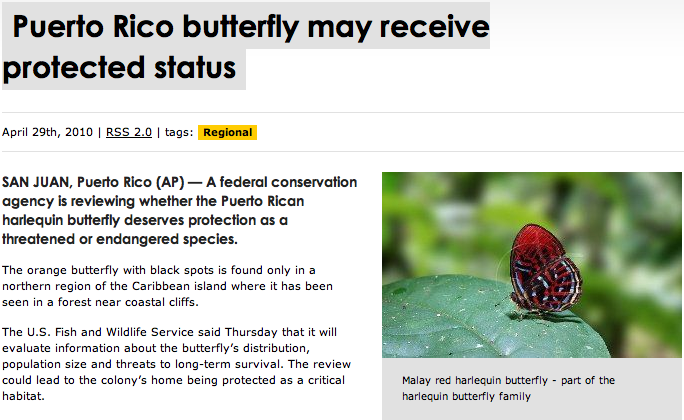
Од страна на Крис Grinter, на 23 јуни, 2010 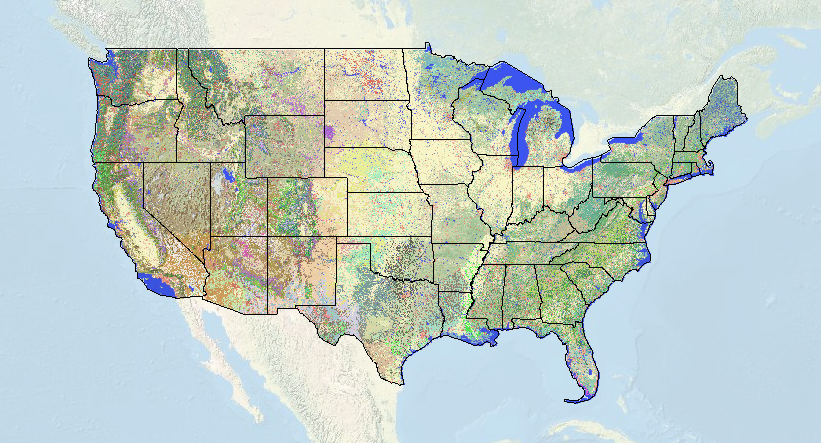
Отсекогаш сум се прашувал како да се најде вистинската терминологија за земјишната покривка во дадена област,. Вообичаено, Јас само груба проценка нешто по должината на линиите на “даб CHAPARRAL”. Но, сега можам да го користам ова прекрасна нова мапа ни донесе USGS/Националната биолошка информациска инфраструктура. Нивото на детали е неверојатно, и можете да го одредите степенот на точност со паѓачкото ливче (1-3). Сега со топо-карта на САД со висока дефиниција можам да видам точно каде се најголемите насади на боровите Монтереј (всушност тоа е а Калифорнија крајбрежни затворени-конусни четинарски шуми и шуми) за да можам оптимално да ја поставам мојата стапица овој викенд.
Continue reading Landscape Cover Map
Од страна на Крис Grinter, На 18 јуни, 2010 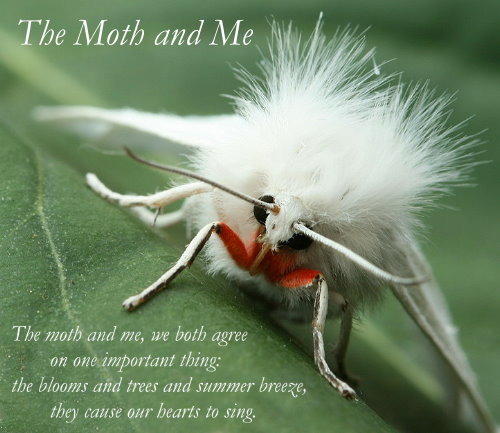
Добредојдовте на молецот и мене #12, и мојот прв блог карневал. И покрај блогирање за неколку месеци имам уште да ги погледне назад и да размислуваат за тоа како точно станав вљубени со Lepidoptera на прво место. Сеќавајќи се на времето или местото каде што се случи ова е невозможно, and like many of my colleagues and I’m sure many of my readers, I had a butterfly net and “bug cage” in hand as soon as I could walk. When it comes to entomology I believe almost everyone falls in love at first with a large and striking insect. For me it was a butterfly, naturally. I can remember staring for endless hours at the diversity of Ornithoptera and Papilio illustrated in Paul Smart’s famous book. Somewhere along the way in pursuit of something new I began to stray into the nocturnal world. Moths comprise the majority of the diversity of Lepidoptera; while there are nearly 11,000 species in the United States, only a few hundred are butterflies. This quickly opened a door (maybe into an abyss…) to the shocking abundance found everywhere around us. This amazing diversity has now drawn me deep into the biology and evolutionary history of the Lepidoptera. Editing these fourteen contributions of moth blogging together I just can’t help but to reflect back on some of my own mothing journey.

Пerhaps if I was a child in Europe this moth (Deilephila elpenor porcellus) would have been the first to catch my eye. Over at Urban Moths Ron Laughton has discovered the stunning diversity in his own back yard in much the same way as I did growing up here in the US. Take a look at the types of traps he has been using, most of which he constructed himself. One of the best behaviors of moths is their willingness to dive headlong into the light. Not too far from Ron, Mike Beale has been blogging british moths as well. It can be pretty amazing just how similar our two faunas are (a few moths actually се the same).
Continue reading The Moth and Me #12
Од страна на Крис Grinter, на 11 јуни, 2010 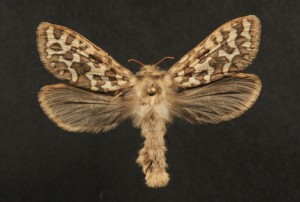
This moth is just about as rare as its paranormal namesake (except that it’s real) – it’s a Gazoryctra sp. in the family Hepialidae. They represent a basal lineage of the Lepidoptera and are commonly known as ghost moths or swift moths. Ghost – because males of some species are known to fly in true leks, where they hover up and down in grassy clearings at dusk while females observe. These same males also call for females with pheromones, a bit of a backward situation with insects. Swift- rather self evident, but boreal species have been known to be powerful flyers.
One of the features that help indicate this as a basal lineage is the placement of the wings on the body, some wing venation, reduced or absent mouthparts and the lack of a strong wing coupling device. These moths have a “jugum”, which is a small thumb like projection from the top of the hindwing. Other lineages of moths have a tight coupling mechanism known as the frenulum and retinaculum, where bristles hook the two wings together so they remain coupled during flight. When at rest the jugum folds around and probably helps keep the wings together – but not while in flight; the forewing is out of sync with the hindwing and flight is not dynamic (Скобл 1992).
In the Americas Hepialid biology is very poorly understood. Only a handful of life histories are described globally – all of which seem to be endophagous (boring) in plant root systems. Some early instar larvae may feed in the leaf litter or underground on the root system before entering the rhizome. Australia is fortunate to have a diverse and impressive fauna of Hepialidae – many are brilliantly colored and enormous (250mm or up to 12 инчи!), and a bit better studied. Some larvae are even common enough that aboriginal tribes have used them as a staple food source.
But back to this moth in particular. I collected it in my black light trap last August up in the Sierra Nevada around 10,500 feet. The species is unknown, and may likely be new. The most frustrating part is that it is the only specimen known to science. The entire genus is very rare, except for one or two commoner species, only a few dozen specimens exist. So is it a female of a species described only from a male? A freakish aberration of an otherwise known species? Or maybe it is actually new. I’ve barcoded the DNA, that actually tells me nothing since there are zero sequences from any closely related species. Всушност, as far as I know, the other species in the Sierra haven’t even been collected in decades so I can’t even get a sequence from an older specimen. The icing on the cake is their behavior. They rarely, ако некогаш, come to light – which may be a result of their crepuscular flight. On the right night they may be on the wing for 20-30 minutes, usually a female searching out a male, or a female flying to oviposit (likely just broadcast scatter their eggs on the ground). So come this late August I’ll be returning to the high Sierra with a few volunteers from the entomology department in hopes of seeing one whiz by me on the steep slopes. If I get some more, it might turn out to be impressive new species for California.
Од страна на Крис Grinter, на 11 јуни, 2010 Who can see what’s wrong with Оваа статија?

Од страна на Крис Grinter, на 9-ти јуни, 2010 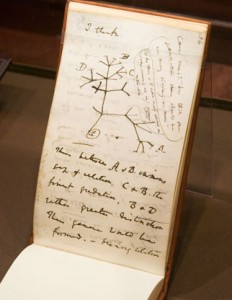
Ова recent article in the American Naturalist has taken a second look at some of the famously inflated species estimates, некои одат високо како 100 милиони (Ервин, 1988). Проценките спроведени од авторите укажуваат на тоа дека проекциите погоре 30 милиони имаат веројатности за <0.00001. Нивниот проценет опсег е поверојатно да биде помеѓу 2.5 и 3.7 million species (with 90% confidence). This seems somewhat reasonable given that these extraordinary estimates were based heavily on extrapolation. There are clearly many difficulties in assessing diversity based on tropical arthropod surveys – this paper again uses phytophagous (plant-eating) beetles for estimates. They are careful to point out that these methods do not account for non-phytophagous insects, but assume that they will follow traditional biogeographic patterns of diversity. This is somewhat of a new concept given that when I was in college I was taught that parasitoids are counterintuitively not more diverse in tropical regions. This hypothesis is more often than not being proven false in the light of more precise modern taxonomic methodology. Rather proudly I helped play a role with the parasitoid project at the UIUC. На кратко, host specificity is more extreme in tropical environments with hundreds of cryptic species hidden amongst rapidly radiating groups such as the microgastrine Braconids (Хименоптера) – the same has held true across similar taxa.
One interesting note about the paper is their inclusion of a secondary estimation based on Lepidoptera canopy assemblages. They assumed that a) all Lepidoptera can be found in the canopy and b) that all leps are phytophagous. This is clearly a very conservative estimation given that not all Lepidoptera are found in the canopy and not all are phytophagous. While I do not have the numbers on hand, a certain percentage of lep diversity must have been excluded from these estimates. I will also go out on a limb and assume that the authors (Novotny 2002) did not include microlepidoptera morphospecies – and most likely estimated abundances with our current taxonomic understanding. However I do not have access to this 2002 paper, so I may be incorrect. Using these Lepidoptera numbers (from the same survey as the Coleoptera) a global diversity was estimated by Hamilton et. al. at around 8.5 millions arthropod species.
While I agree that extraordinary estimates of tens of tens (or hundreds) of millions of arthropod species are probably ridiculous; I am of the camp that current research is indicating that estimates of the lower tens of millions of species are possible. The authors have failed to include research that counterbalances their premise that tropical species exhibit a lower beta diversity (Novotny 2002, 2007). In the same journal, Природата 2007, Dyar et. al. have indicated that the American tropics exhibit a higher beta diversity than previously assumed. Either it can be said that estimates of beta diversity in the australasian tropics are incorrect, or they are incompatible with species assemblages of neotropical forests. All of this speaks to the difficulty in extrapolating estimations of species across all tropical regions. These estimates are based on comprehensive insect surveys of New Guinea, perhaps they do not accurately reflect the true diversity of American tropical forests, and these number ranges are low.
As a final thought, most assesments are focused on tropical arthropods. It seems all too possible that the total number of all species, including bacteria and archaea, can easily exceed tens of millions. But extrapolating those numbers is even more precarious than arthropods, given the extreme lack of knowledge we have.
Од страна на Крис Grinter, на 4 јуни, 2010 
Не може да се најде начин да се поврзе директното видео (дури ни VodPod), but here is the link to the Daily Show site. Колку физичари ја извадија косата кога ја слушнаа оваа? Нели, тој е новоназначен портпарол. Don’t worry Neil, не одиш никаде после ова.
Having not aired yet I can’t tell exactly how apologetic the show е, but it seems heavily focused on finding the “creator”. I can hear it in John Stewart’s voice when he pulls back from ripping into Freeman’s “god of the gaps” theory. Perhaps there was an edit and we missed the question where John Stewart asked “Morgan, can you define a logical fallacy for us… perhaps the god of the gaps one?” I believe that any physicist who ever says “god was responsible” says it with no deeper meaning than when Einstein famously evoked god’s dice. That’s to say, a non-literal and non-personal god found only in the beauty and splendor of nature.
Од страна на Крис Grinter, on June 2nd, 2010 
If there is one thing that I learned in college, it was how to easily distract myself. I tend to keep my TV on in the background while I’m working on my computer, especially late at night when I am usually fighting a winning war against sleep. The other night something did catch my eye: a man holding dowsing rods in his back yard. Volume up, let the bullshit flow. It was just a flash of idiocy in an otherwise good program on home improvement. I’ve become accustom to crap-based TV on networks such as the History Channel or a Discovery network (quality of their shows include gems like “The Haunted: ghosts and pets”), but I was a little surprised to see BS grace my local PBS station.
Over on the “American Woodshop” host Scott Phillips was constructing a beautiful garden arbor. You can watch the entire thing here for free: Episode 1609: Period Architectural Moldings and Trim. There are no time stamps on the clip, but the dowsing comes in around the mid-point. While demonstrating the materials needed to secure the wood to the ground he cautioned against digging haphazardly into your yard without knowing where the underground water, electrical or gas lines were: solid advice. So in order to do this you should (парафразиран) “take pieces of coat-hanger, anything will do, turn them into an “На”. As I walk forward the bars cross – there (they cross) – right there is the irrigation line. 9 надвор од 10 people have this ability, but you should call in a professional if there is any doubt“. My translation “OK guys, don’t worry about calling in some guy to do this, figure it out this way”. Please tell me what man who seriously watches a home improvement show at midnight would cede authority to someone else before giving it the good ol’ college try? Even if we grant for a moment that 9 надвор од 10 people could do this, what about that one guy who can’t? Isn’t it irresponsible to suggest that you can avoid power/water/sewer/gas only 90% of the time? Упс, hit that pesky gas line…
Being a scientist, a skeptic and a procrastinator – I wrote Scott a message about this so I could avoid my work at hand. Today he kindly replied saying: (excerpt)
“Our bodies are electromagnetic fields. Disrupt a field and things happen…. I learned the technique mentioned from a city worker that they used to find lines. Not from a charlatan. My team witnessed the objective use of this technique.”
Briefly, нема, our bodies are not electromagnets. Everyone can hold a compass, or TV… without screwing them up. Franz Mesmer coined the idea of “Animal Magnetism” in the last half of the 18th century (also invented “mesmerization” AKA hypnotism) – and had it abruptly debunked by Benjamin Franklin and others. I’m also a bit worried to hear that city workers are relying on dowsing to locate public lines! But to move onward, let us dig into the myths of dowsing. I agree that there seems to be somewhat of an intuitive truth when it comes to dowsing, however false it is scientifically, it remains compelling. Секако… electrical things underground effect sensitive wires above. And wow, look at all these guys who can find water, or power, или… lost people… или bombs? Ред, let’s stick to water for this conversation.
(continued)
Continue reading An Uphill Battle
Од страна на Крис Grinter, на 1 јуни, 2010 Само неколку слики од обичните калифорниски лепи, направено по должината на брегот во близина на Санта Круз пред неколку недели. Почнувам да работам низ некои заостанати фотографии…

Euphydryas chalcedona
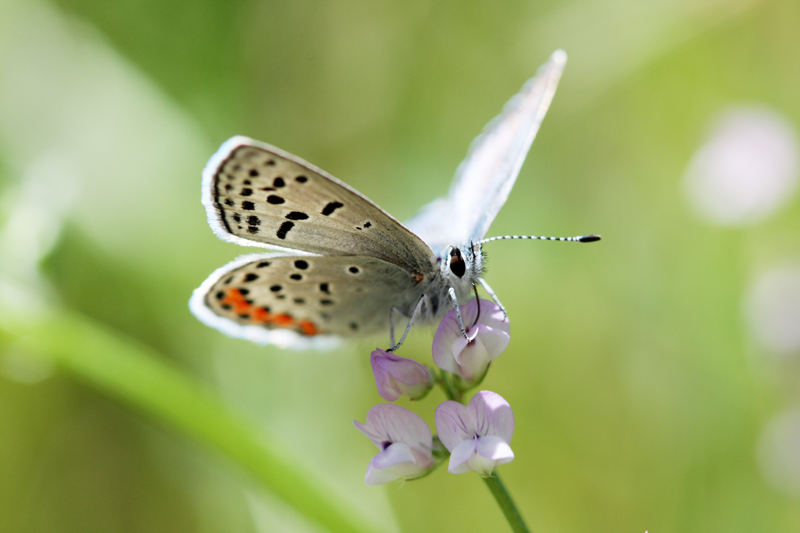
Plebejus acmon
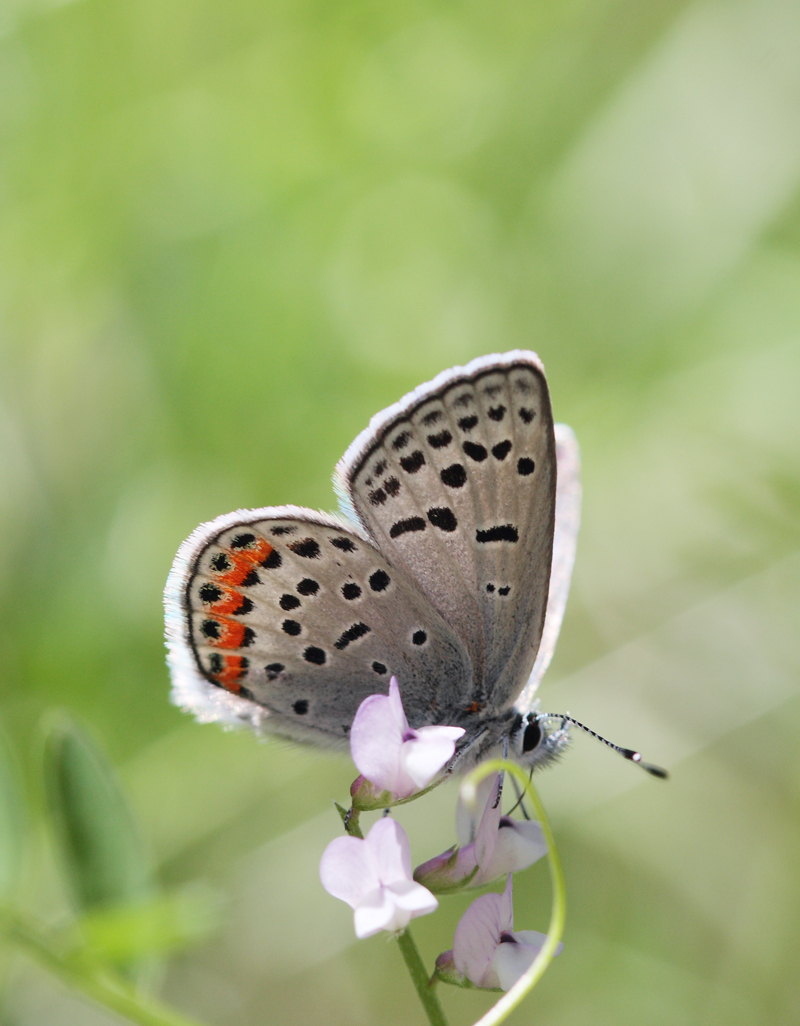
Plebejus acmon

Ethmia arctostaphylella на Eriodictyon sp.
Една интересна забелешка за Ethmia arctostaphylella – името е погрешно име, всушност не се храни Арктостафилос (Манзанита). Во времето на описот во 1880 Волсингем пронашол ларви како куклички на листовите на манзината и претпоставил дека тоа е нивното растение домаќин. Во неверојатната монографија на Џери Пауел за групата, тој посочува дека овој молец е одгледан Ериодктион – кој случајно е цветот на кој се качи молецот. Двете растенија растат рамо до рамо, и прилично е лесно да се види како скитничка гасеница го наоѓа својот пат кон соседот.
|
Скептицизам
|













